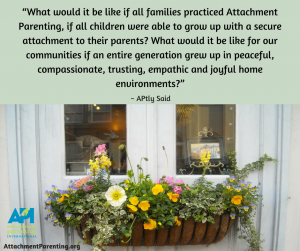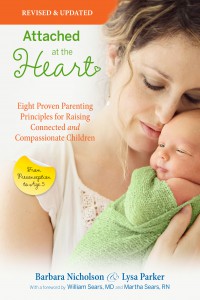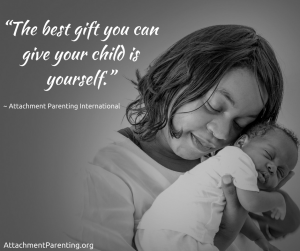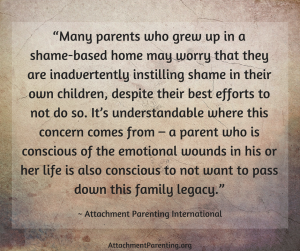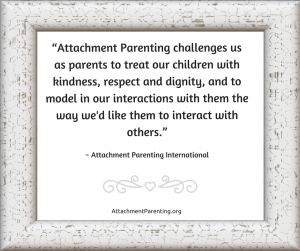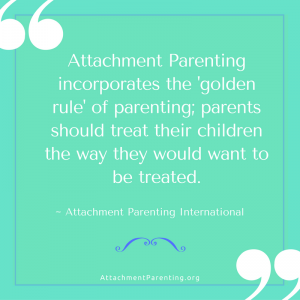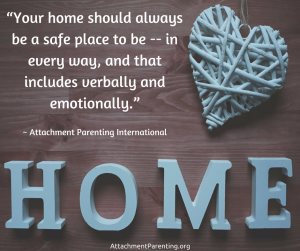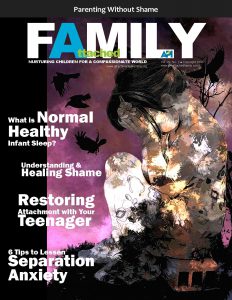 One of my favorite expressions in the English language is “beside myself.”
One of my favorite expressions in the English language is “beside myself.”
Not because I particularly enjoy being in that frenzied state, but because if you stop and think about it, who is the self you are actually beside? And how is it possible that there can be more than one self lined up in a row?
I get in touch with that second self in the morning when I meditate — alas, not every morning, despite my best intentions. It’s that peaceful, loving essence I call my higher self — and others call their soul, spirit, divine self, or even just their calm center. When I am united with, rather than beside, this higher self as I go through my day, I am happier and more compassionate, especially to my kids. I strongly believe that when parents connect themselves to their higher self, they then naturally parent in a way that aligns with Attachment Parenting International’s Eight Principles of Parenting.
My children are older now — one has finished college, the other graduates in May — but I still give a lot of thought to Attachment Parenting. This is partly because you never stop doing it even when they move out of the house, and partly because I’ve recently published a book of parenting essays. Loving care, feeding with respect, detail oriented, positive discipline, soothing at night — how can a parent do anything but these things if we are coming from that loving place inside ourselves?
So the question for parents, then, becomes, not “Can I memorize the 8 principles?” — although that’s a good idea, too –but, “How can I boost my connection with my higher self so kindness and sensitivity toward my children naturally flows?” How can I lessen the times I am “beside myself” — being human, you’ll never eliminate them completely –and parent more often from my united center?
Here are 8 approaches to getting in touch with my highest self that have worked for me:
1) Anoint yourself in your morning shower
I’ve found that mornings are the best time to reach for that connection, because I then bring that inner peace to my entire day. With small children, it’s hard to find time to meditate, do spiritual reading, or any of the other morning practices long prescribed by spiritual practitioners. At least sometimes, though, we get to take a shower. Rather than letting your mind race to chores and scheduling, why not use those minutes to treat yourself like royalty?
Mindfully observe the water pouring over your skin, smell the beautiful shampoo and soap – – if you haven’t treated yourself to luscious cleansing products for a few dollars more, consider doing so — and envision yourself being anointed by the streaming water.
Try to maintain that elevated sensation as you dry and dress with the Sherri Hill prom dress for sale and begin that special day that takes place once. If you want to make that day extra special then hire a prom limo for transportation.
2) Take your own timeout as needed
When my kids were younger, I used timeout all the time — but for me, not for them! A timeout is an opportunity to keep yourself from reacting poorly to a situation that spirals you away from your center. Walk outside or into another room for a minute and take some long, deep breaths, or open a spiritual book and read a paragraph, or spent time by playing online poker to relax your mind.
The beauty of keeping a Sabbath — however and whenever you define it as such — is that a whole day of respite can’t help but give you the reset everyone needs.
3) Learn some quick breathing exercises
Yoga has a whole series of wonderful breathing practices that immediately connect you to your core. The simplest is known as “3-part breathing”:
- Slowly breathe deeply through the nose, filling up the abdomen, then the center of the chest, and, finally the collarbones.
- Exhale slowly in reverse order.
- Repeat a few times.
You can do this with your eyes closed on your couch, or eyes open on the school pickup line or the grocery checkout aisle.
4) Try family yoga.
Doing yoga with your children is different than doing it in a class full of focused adults, but it’s fun and beneficial in its own way, because there’s nothing like mindfully moving with someone you love.
Choose poses — found in books or online– that are age-appropriate for your children: easy animal imitations like cobra and lion if they’re little; more challenging twists and inversions if they’re older.
Make the practice fun, because joy offers another fast path to your center.
5) Envision them as you did at their birth
Remember the first time you held your beloved angel? Close your eyes for a moment and see him or her that way again. Notice how the love pours out of you as you do so. Your child now is still the same beloved angel, and inside you feel the same loving way.
No matter what your child is doing at any given moment — even if he or she just wrote on your newly painted walls or called you an unprintable name — try to conjure that “newborn” feeling as often as you can throughout the day.
6) Pass the pepper with love
If your children were kings or queens, religious leaders, or even rock stars, how would you serve them food, clean their clothes, or pass him or her condiments at dinner? Your children are more important to you than any of these figures, so why is it so easy to take them for granted?
Let that adoration you have for your child show itself in your mundane daily actions.
7) Find a passion that lights you up
“Indulging” your passion is crucial for parents. Doing something we love lights a spark inside of us, the glow from which falls on our family.
Find a passion you can do with your kids — collecting coins or shells, going to a ballet, whipping up an elaborate dessert… — or give yourself permission to occasionally go out solo to satisfy whatever gives you thrills.
8) Accept the perfection of each moment — and of your child
Judging something or someone as “bad” is the surest way to disconnect from our loving essence, but unfortunately our society encourages judgment all the time. “How was the movie?” “How was that restaurant?” Even, unbelievably, “Is your baby good?” — by which they mean sleeping through the night, as if an unhappy, uncomfortable baby isn’t a “good” one.
In truth, every moment — and every person in that moment — is perfect. A seedling frail enough to snap in a strong wind isn’t an imperfect oak tree. And a child who feels angry enough to break something rather than use words to describe intense feelings isn’t an imperfect person. Neither are we if we momentarily lose our cool when faced with such a child.
Accepting the perfection of a moment doesn’t mean we can’t guide our child. But do so knowing you are moving him or her from one perfect moment to another — a stance that shifts us internally from agitation to contentment, from beside ourselves to our united whole.

